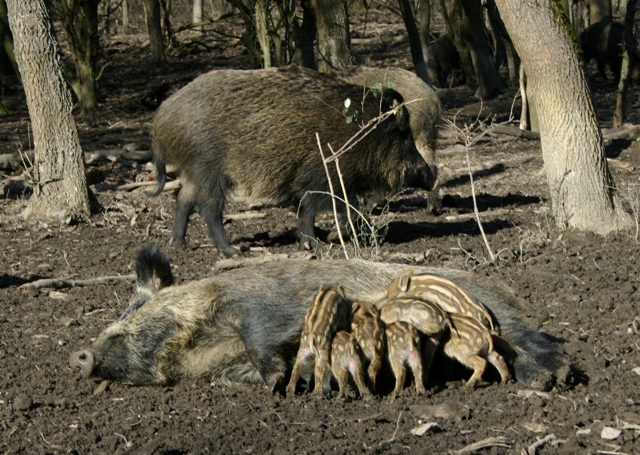Aug 14 2015
The wild boar population in Europe has been constantly growing since the 1980s. This is more and more becoming a problem for agriculture when animals raid the fields, looking for feed. “It is not so easy to determine the number of wild boars in Europe,” says wildlife biologist and first author of the study, Sebastian Vetter. “Therefore we analysed data on hunting bags and road accidents involving wild boar. Doing this we were able to depict the growth of the wild boar population.”
 Wild boars produce a very large number of offspring compared to other ungulates. (Photo: Sebastian Vetter/Vetmeduni Vienna)
Wild boars produce a very large number of offspring compared to other ungulates. (Photo: Sebastian Vetter/Vetmeduni Vienna)
More wild boars after mild winters
Vetter and his colleagues compared annual wild boar population growth to temperature and precipitation data from twelve European countries, with data being available for up to 150 years in some regions. They identified a clear trend. “There is a sharp increase in the number of wild boars after mild winters. As mild winters are becoming more frequent, also wild boar populations are growing exponentially,” Vetter explains.
One reason is thermoregulation. If temperatures are very low, a lot of energy is necessary in order to maintain a high body temperature. As a consequence, less energy is available for reproduction and rearing the offspring in the following year. Furthermore, harsh winters claim the lives of many young animals. In warmer winters, more piglets survive.
Availability of feed makes hard winters bearable
Wild boars mainly feed on beechnuts and acorns. In so-called mast years when these trees bear a lot of fruits there is abundant feed available for the pigs. Such mast years occur in irregular intervals and, during the last decades, increasingly frequent. If a harsh winter is preceded by a mast year, the animals have enough energy for thermoregulation. The population can continue to grow despite unfavourable temperatures.
Regional differences affect wild boar populations
A wild boar population only grows in the following season if the average temperature during winter has reached a certain threshold. In southern regions this threshold is higher than in the north. “These regional differences are due to the animals’ body size. Wild boars in the south are smaller than those in the north. This changes the relation of body surface and volume and hence heat dissipation. Being small is unfavourable in the cold but thermoregulatory beneficial during hot southern summers. Regionally differing body size of wild boar is the reason why population growth began virtually simultaneously throughout Europe, despite considerable differences in winter temperatures”, Vetter explains.
Vetter and the research team at FIWI working with wild boars are going to continue their research in this field. “Wild boars produce a surprisingly large number of young animals compared to other ungulates. This enables the strong growth of populations which we are currently observing. Therefore we are particularly interested in the factors that influence reproduction of this species,” Vetter underlines.